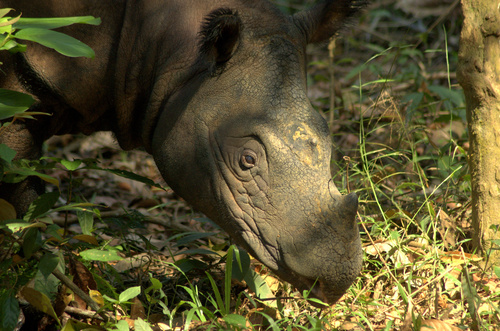
Sumatran Rhinoceros
The Sumatran rhinoceros, Dicerorhinus sumatrensis, is a small, hairy rhino inhabiting dense tropical forests. Known for its unique vocalizations and prehensile lip, this critically endangered species plays a crucial role in its ecosystem by aiding forest regeneration and maintaining plant diversity.
500.0 - 800.0 kg
Weight
Length: 2.0 - 2.5 m
Size
Brown, Grey, Black
Color
30 mph
Top Speed
Critically Endangered
Conservation Status
Decreasing
Population Trend
Characteristics
Dicerorhinus sumatrensis, known as the Sumatran rhinoceros, is the smallest and hairiest of all rhinos. It inhabits dense highland and lowland tropical forests in Sumatra and Borneo. This solitary and elusive herbivore has a distinctive prehensile upper lip and is known for its vocal communication.
Distribution Range of the Sumatran Rhinoceros
The Sumatran rhinoceros (Dicerorhinus sumatrensis) is native to Southeast Asia. Historically, its range included parts of India, Bhutan, Bangladesh, Myanmar, Laos, Thailand, Malaysia, Indonesia, and potentially southern China. However, due to habitat loss and poaching, its current range is restricted primarily to Indonesia, specifically on the islands of Sumatra and Borneo.
Sumatran Rhinoceros's Habitat
Environmental Conditions
The Sumatran rhinoceros typically inhabits dense tropical and subtropical forests, both lowland and montane, up to elevations of 2,000 meters. It thrives in areas with thick undergrowth and abundant water sources, which are essential for its wallowing behavior.
Ecological Niche
This species is a solitary browser, feeding on a wide variety of plant species, including leaves, twigs, bark, fruit, and shoots. It plays a crucial role in its ecosystem by aiding in seed dispersal and maintaining the health of the forest understory. The Sumatran rhinoceros is adapted to a life of seclusion and is rarely seen, relying on its keen sense of smell and hearing to navigate its dense forest habitat.
Copyright @ Nature Style Limited. All Rights Reserved.
 English
English